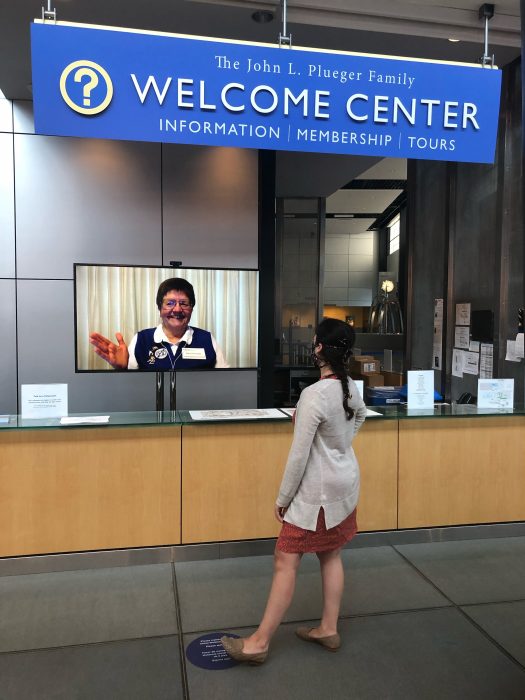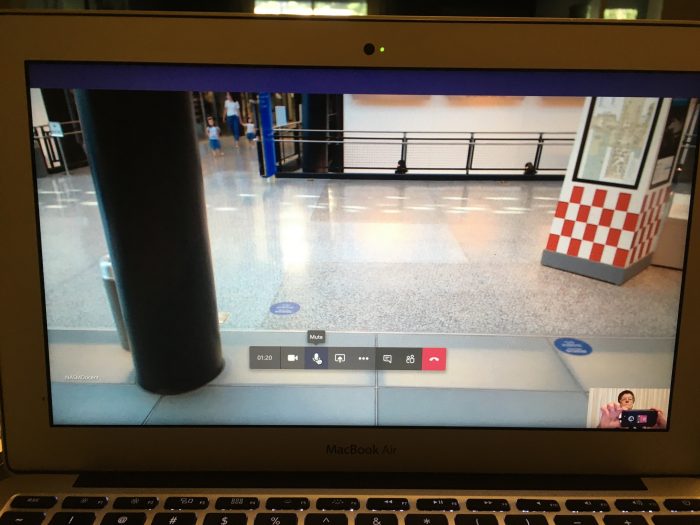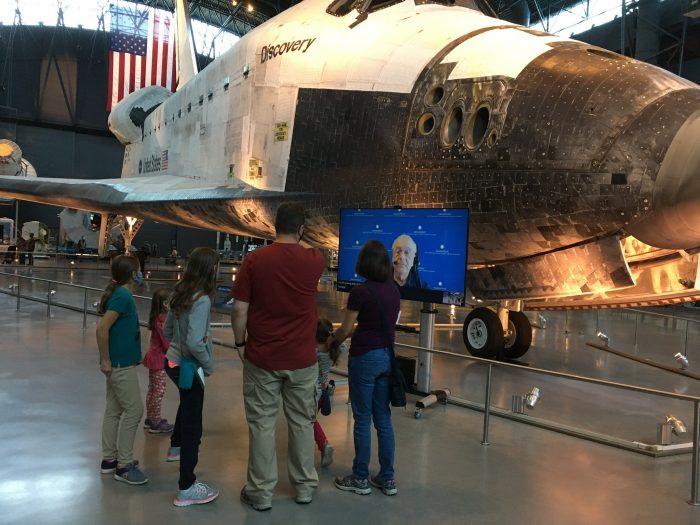Virtual volunteering in the age of Covid: Or How I became Max Headroom
Volunteer Mary Dominiak explains what it’s like to be a literal “talking head.”

When the National Air & Space Museum Steven F. Udvar-Hazy Center reopened to the public on July 24, 2020, Visitor Services premiered a pandemic-conscious “Virtual Volunteer” station at the Welcome Center. Where we Blue Crew volunteers (named for our distinctive blue vests) used to offer maps and answer questions in person for museum visitors, we now can do the same from a safe social distance by appearing on a 65-inch monitor screen in the museum while sitting in our own homes.
So: what is it like? First of all, it’s fun! It’s also hilarious, because even though people have gotten accustomed to virtual meetings, virtual classes, and even virtual wine tastings, most still don’t expect a welcoming face and waving hand on a TV screen to belong to a live human being. Their surprise and delight are infectious when they realize that what they assumed to be a proximity-triggered recording – like those animated Halloween and Christmas decorations – is a real person who can actually see, hear, and interact with them. Many take selfies with our Virtual Volunteers! The Welcome Center monitor near the entrance has worked so well that there’s now a second monitor down at the Tours Desk on the main hangar floor, and museum docents appear on monitors stationed beside some key museum artifacts to help visitors learn more even while in-person tours aren’t feasible.

Technology makes it all possible. The museum employs Microsoft Teams software to power the links to monitors. Staff volunteer coordinators offer 90-minute training sessions once or twice a month for experienced Blue Crew and qualified docents who’d like to go virtual. The training mostly involves learning how to use Teams, including how to log into and out of sessions smoothly; what to expect based on the experience of folk who’ve already done it; some suggestions on best practices to be physically equipped and ready for a shift; and how to sign up for shifts, report hours, and track interactions with the public in VSys (our volunteer management system).
The major differences from working shifts in person are that only one volunteer is on duty at a monitor station at a time, and the duty shifts are much shorter than the half- or full-day ones we usually work. Virtual Welcome Center shifts are one hour long, while the Tour Desk monitor – which sees less activity, as a rule, but often longer, more detailed interactions – employs 90-minute shifts. The shorter shifts are important, because when you’re on, you’re literally “on;” there’s no one next to you able to step in and take your place if you need a break. I’ve done two hours in a row with no difficulty, but I wouldn’t want to try more; hey, just sitting that long is something I’m not used to doing! On-site staff coordinators monitor the chat window, so you get quick response to any issues.

Sound is the single biggest challenge with the current Virtual Volunteer stations. The monitors are linked to webcams with integrated omnidirectional microphones, which means you hear absolutely everything around you at a single volume level. At the Welcome Center, that often includes not only the person asking you a question, but the screaming toddler down the blind hallway behind you, the janitorial cart click-clacking across the terrazzo floor toward the gift shop, and the jet-engine whine of the hand dryer in the nearby ladies room! Every problem has a fix; we’ll figure this one out.
I never thought I’d turn into a literal talking head on a TV screen – shades of the 1987 television show Max Headroom! – but I’m glad I can be in my museum helping visitors enjoy themselves even while I’m not physically there. If you get the chance, volunteer to go virtual in your museum!
A lifelong plane crazy space cadet, EPA retiree Mary Dominiak began volunteering with Smithsonian as a voice actor/narrator in 2013, and joined the NASM Visitor Services “Blue Crew” in 2016. Mary completed NASM docent training in 2020, but hasn’t been able to give a tour yet.
Posted: 11 November 2020
- Categories:







